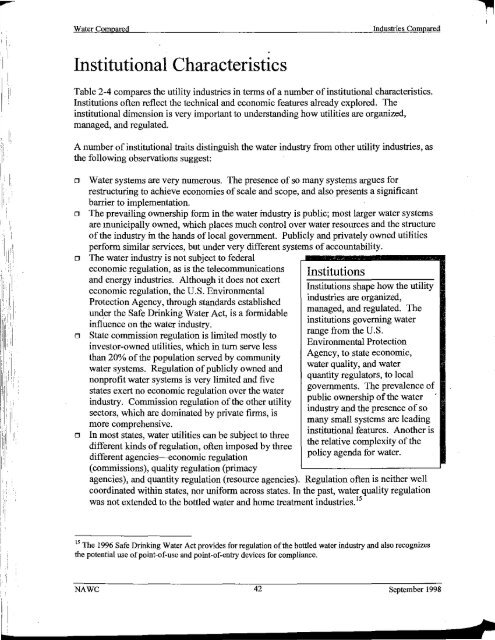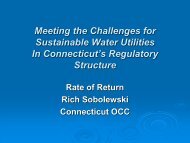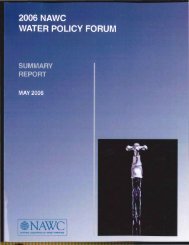BEECHER - NAWC
BEECHER - NAWC
BEECHER - NAWC
Create successful ePaper yourself
Turn your PDF publications into a flip-book with our unique Google optimized e-Paper software.
jWater ComparedIndustries Compared! ! 'Institutional CharacteristicsTable 2-4 compares the utility industries in terms of a number of institutional characteristics.Institutions often reflect the technical and economic features already explored. Theinstitutional dimension is very important to understanding how utilities are organized,managed, and regulated.·· IA number of institutional traits distinguish the water industry from other utility industries, asthe following observations suggest:·I,iIj,,, ::1':II'.1'·'' .,.viI· ·,II,,,,~1,ooo0oWater systems are very numerous. The presence of so many systems argues forrestructuring to achieve economies of scale and scope, and also presents a significantbarrier to implementation.The prevailing ownership form in the water industry is public; most larger water systemsare municipally owned, which places much control over water resources and the structureof the industry in the hands oflocal government. Publicly and privately owned utilitiesperform similar services, but under very different systems of accountability.The water industry is not subject to federaleconomic regulation, as is the telecommunicationsand energy industries. Although it does not exerteconomic regulation, the U.S. EnvironmentalProtection Agency, through standards establishedunder the Safe Drinking Water Act, is a formidableinfluence on the water industry.State commission regulation is limited mostly toinvestor-owned utilities, which in turn serve lessthan 20% of the population served by communitywater systems. Regulation of publicly owned andnonprofit water systems is very limited and fivestates exert no economic regulation over the waterindustry. Commission regulation of the other utilitysectors, which are dominated by private firms, ismore comprehensive.In most states, water utilities can be subject to threedifferent kinds of regulation, often imposed by threedifferent agencies--economic regulation(commissions), quality regulation (primacyInstitutionsInstitutions shape how the utilityindustries are organized,managed, and regulated. Theinstitutions governing waterrange from the U.S.Environmental ProtectionAgency, to state economic,water quality, and waterquantity regulators, to localgovernments. The prevalence ofpublic ownership of the waterindustry and the presence of somany small systems are leadinginstitutional features. Another isthe relative complexity of thepolicy agenda for water.agencies), and quantity regulation (resource agencies). Regulation often is neither wellcoordinated within states, nor uniform across states. In the past, water quality regulationwas not extended to the bottled water and horne treatment industries. 1515The 1996 Safe Drinking Water Act provides for regulation of the bottled water industry and also recognizesthe potential use of point-of-use and point-of-entry devices for compliance.<strong>NAWC</strong> 42 September 1998
















